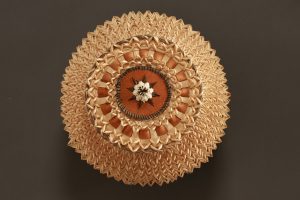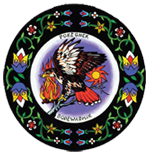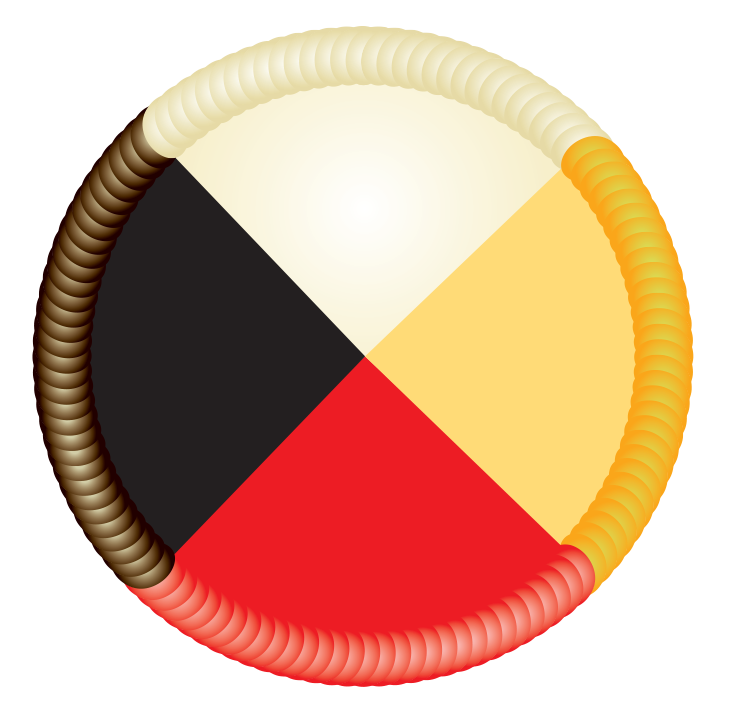Living the Seven Grandfather Teachings
Pokagon citizens have long sustained their culture and connection to their homeland; numerous place-names in northern Indiana and southwest Michigan continually reflect that connection. The Pokagon people have endured thanks partly to their values of Wisdom, Love, Respect, Truth, Honesty, Humility, and Bravery. Adapting these deeply-rooted ideals to contemporary circumstances has made the Band an engine for economic development and a model for sustainable living in the region.
Pokagon Band citizens take great pride in the enormous strides the Band has taken to further economic development, develop tribal infrastructure, and resources, and improve healthcare, housing, education, and Elder services to its citizens. In addition, the Pokagon Band has made it a priority to develop language and cultural programs for its citizens, through its Department of Language and Culture, in an effort to fully engage the Pokagon Band community in the cultural heritage and the traditional lifeways of the Pokagon people. They recognize their clan identity and remember their ancestors’ presence in modern-day gatherings like pow-wows. Elders and youth come together to mark seasonal changes with ceremonies and feasts, practice traditional arts such as black ash basket making, and play age-old games.
Every year, Potawatomi tribes from around the country gather together as one people for much celebration.
Seven Grandfather Teachings
Our form of being within creation was created differently by Kchémnedo for this physical world. Kchémnedo blessed us with a gift that no other creation can obtain. Our gift from Kchémnedo was the ability to exercise free-will. A flower cannot choose to be a tree, nor can a bird choose to be a butterfly. They have been created and placed upon Nokmeskinan so that they shall live out their responsibilities just as Kchémnedo intended. A neshnabé has the opportunity to experience this physical world as a free-being. Free to choose the decisions that navigate him/her on their own path in this beautiful physical journey while respecting and supporting all of our relatives along the way. Our Grandfather teachings help to guide our free-choice so that we may travel our journey with the guidance and stability that enables us to live a healthy life. These teachings ground, guide, and nurture our free choices so that we may remember the Neshnabé way of being, the being that Kchémnedo set down so lovingly long ago.
History
Each Indigenous nation has its own creation story. Some stories tell that the Potawatomi have always been here. Other stories tell of migration from the Eastern seaboard with the Ojibwe and Odawa Nations. The three tribes loosely organized as the Three Fires Confederacy, with each serving an important role. The Ojibwe were said to be the Keepers of Tradition. The Odawa were known as the Keepers of the Trade. The Potawatomi were known as the Keepers of the Fire. Later, the Potawatomi migrated from north of Lakes Huron and Superior to the shores of the mshigmé or Great Lake. This location—in what is now Wisconsin, southern Michigan, northern Indiana, and northern Illinois—is where European explorers in the early 17th century first came upon the Potawatomi; they called themselves Neshnabék, meaning the original or true people.
As the United States frontier border moved west, boundary arguments and land cessions became a way of life for Native Americans. In 1830, the U.S. Congress passed the Indian Removal Act and directed that all American Indians be relocated to lands west of the Mississippi River, leaving the Great Lakes region open to further non-Indian development.
The 1833 Treaty of Chicago established the conditions for the removal of the Potawatomi from the Great Lakes area. When Michigan became a state in 1837, more pressure was put on the Potawatomi to move west. The hazardous trip killed one out of every ten people of the approximately 500 Potawatomi involved. As news of the terrible trip spread, some bands, consisting of small groups of families, fled to northern Michigan and Canada. Some also tried to hide in the forests and swamps of southwestern Michigan. The U.S. government sent soldiers to round up the Potawatomi they could find and move them at gunpoint to reservations in the west. This forced removal is now called the Potawatomi Trail of Death, similar to the more familiar Cherokee Trail of Tears.
However, a small group of Neshnabék, with Leopold Pokagon as one of their leaders, earned the right to remain in their homeland, in part because they had demonstrated a strong attachment to Catholicism. It is the descendants of this small group who constitute the Pokagon Band of Potawatomi Indians.
When the American immigrants first came to southwestern Michigan in the early 19th century, they would have found Leopold Pokagon and his village in what is now Bertrand Township in Niles, Michigan. In 1838, Leopold and a small group from the St. Joseph Valley visited the Odawa at L’Arbre Croche to attempt to find a place to settle, for while the Treaty of 1833 allowed them to remain in Michigan, they were supposed to remove to the L’Arbre Croche area with the Odawa within five years. In 1836 the Treaty of Washington was struck between the Odawa and Ojibwe and ceded much of the lands in the north. Essentially, Leopold and his group were told there would be no room for them to move there. Upon returning to southwest Michigan, Leopold purchased land in Silver Creek Township using annuity monies accrued through several previous treaty negotiations, including the Treaty of 1833. It was in this time that Pokagon and several other groups moved collectively to Silver Creek Township, near present day Dowagiac, Michigan. Not long after, Brigadier General Hugh Brady threatened to force Pokagon’s Band out of Michigan. Pokagon, who by then was an old man in failing health, traveled to Detroit to get a written judgment from Epaphroditus Ransom of the Michigan Supreme Court to remain on their land.
Nearly one hundred years later, during the Great Depression, the federal government passed the Wheeler-Howard Act, also known as the Indian Reorganization Act of 1934, which would provide tribes with resources to reestablish tribal governments. Although the Pokagon Band applied for recognition, the Bureau of Indian Affairs had limited funding and personnel to fully implement the Act, so decided to recognize only one Indian tribe in the lower peninsula of Michigan (the Saginaw Chippewa Indian Tribe). It wasn’t until September 21, 1994 that the federally-recognized status of the Pokagon Band of Potawatomi was reaffirmed by an act of Congress. After decades of effort by hundreds of Pokagon Band citizens and other volunteers, the Pokagon Band’s sovereignty was restored on that day in a signing ceremony at the White House with President Bill Clinton. This day is now celebrated as Sovereignty Day by citizens of the Pokagon Band. This Act did not mean that the Pokagon Band suddenly became an Indian tribe, rather that the federal government reaffirmed what the Pokagon Band had always known — they were a tribe.
Dance
Native dancers are drawn to dance for different reasons. Some children are encouraged to dance and be competitive pow wow dancers. Others attend pow wows as children and take an interest on their own. “I would bop up and down on my parent’s lap, and so they decided to make me an outfit, and I’ve been dancing ever since,” remembers one dancer.
Dancing in the old village days helped dictate community members’ social interaction and mediation. A round dance historically introduced and integrated the clans. Jinktamek (to celebrate) was a way to celebrate the harvest times, seasonal changes, marriages and special envoys for other nations. Historically, Jinktamek would last up to four days with singing, dancing and feasting integrated with social etiquette teaching and family lineage recounting.
Contemporary native dance events like pow wows have a different feel. Old ones tell that we should dance for the people, that if you have that gift, you’re good, and people enjoy watching you, you should dance for those who can’t: for elders those who don’t have the strength, for someone who is having a bad day, to help lift up their spirits and pray for them with dance.
Fulfilling the role of a dancer is not easy; it takes a lot of work and at times may even seem a heavy load. Creating regalia involves time, creativity and money, and feathers and regalia command a lot of care and respect. “You have to be disciplined with your outfit,” says one dancer. But if dancing will help an elder who might like to see your dance, or show technique to a child who can learn from you, doing that for the community is a good thing. Answering the call to dance for the people is more relevant than ever with the emergence of contest pow wow culture where a dancer can earn thousands of dollars in a weekend.
There are several categories of dancers and dances.
Men’s Traditional
These dancers preserve the old way of dancing and tell of former war or hunting expeditions. Through a combination of graceful and dramatic gestures, the traditional dancer tells his story. These men wear exquisite beadwork and feathers that are characteristic to their particular nation, clan and/or family. The ensemble may frequently include pieces handed down for generations within the family, and may range from a look of dignified simplicity to the dramatically elaborate. The dance style is similar to the outfit itself—elaborate, expressive and powerful, but not so flashy and exuberant as other men’s styles.
Men's Grass
Several tribes remember the grass dance as being part of the preparation in making a clearing for ceremony. The regalia is decorated with long, multi-colored yarn fringes which sway gracefully with the movement of the dancers’ bodies and are reminiscent of the long, blowing grasses of the prairie. That fringe originally started out as sweet grass hung from the regalia. The dance movements are distinctive for their sliding, shaking and spinning motions, rather than the high kicking steps of the fancy dancer.
Men's Fancy
Known for their stamina, high jumps, and quick footwork, fancy dancers dazzle. Their outfits are constructed of two multi-colored bustles (worn around the neck and back), matching bead work, and whips which are held to emphasize the elaborate gestures of these spirited dancers.
Women's Traditional
These dignified women are admired for the respectful manner in which they dance. Their feet never completely leave the ground, symbolizing their close connection to Mother Earth. Their regalia ranges from intricately sewn ribbon-work cloth dresses to beaded hide dresses. Most are covered with cowrie shells, elk teeth, silver, porcupine quills, and other decorative objects. These women are referred to as the backbone of the tribal nation and they dance in a sedate and stately manor, often simply standing in place rhythmically dipping and swaying to the beat of the drummers.
Women's Jingle Dress
Based upon a young Ojibwe woman's dream, the jingle dress dance is considered a healing dance. Jingle dress dancers are often called upon to dance for a sick or injured community member. To be a jingle dress dancer, you must have dreamt about being one. Traditionally, 365 metal cones are secured on the dress representing each day of the year and a prayer is put into each cone. During the honor beats of a song, the jingle dress dancer uses her fan to spread the prayers into the four directions as the prayers are released from the dancing cones.
Women's Fancy Shawl
Compared to butterflies, these light-footed dancers wear brightly fringed shawls over their shoulders, which complement the twirling, prancing pirouetting steps of this high spirited dance. The word fancy refers to the footwork, not the shawl. Legend says that the young ladies and their shawls represent the transition from a cocoon to a beautiful butterfly. Beadwork and accessories match the multi-colored shawls, creating a splendor of intricate footwork.
Art
The Pokagon Band community boasts numerous talented artists. Some create traditional pieces using old ways, such as black ash baskets, stone or wood carving or pottery. Others are inspired by contemporary media or creative outlets, like photography, body art or jewelry.
Traditional arts served a function and were made from materials found in nature. Baskets made from black ash trees carried harvests and other items. Potawatomi made drums and rattles to use in celebrations and ceremonies, and crafted them from elk or deer hide and wood. Bead and quill work adorned special clothing or items for spiritual purposes.
“Our people have been making baskets for a thousand years,” says John Pigeon, Pokagon citizen and seventh generation black ash basket maker. “Even without knowing me, my ancestors passed this gift down to me. And I want my grandchildren and their grandchildren to hold onto these things just like I did.”
John Pigeon is a past recipient of the Michigan Heritage Award, and other Pokagon artists have been honored with awards, apprenticeships and residencies acknowledging their role as community leaders and tradition bearers. Such institutions as the Eiteljorg Museum of American Indians and Western Art in Indianapolis, the Heard Museum in Phoenix, Arizona, the Smithsonian Folklife Festival in Washington D.C. and the Annual Art Market at the National Museum of the American Indian have recognized their cultural contributions and work.

The Brown family includes several generations of black ash basket makers. Jamie Brown’s large strawberry basket was featured on the cover of an issue of the National Museum of the American Indian magazine, and the Smithsonian Institute purchased and will soon display that piece. Jennie Brown, Jamie’s mother, won the Daniel “Gomez” Mena Master Apprenticeship for her work as a mentor to her fifteen-year-old son and apprentice, Josiah
 Jason S. Wesaw is a pottery artist, photographer and singer and drummer. His preferred medium is clay, because he is able to build something from a piece of the earth. “I have harvested clay from near Lake Michigan, and I am able to give a voice to that material.” Another pottery artist is Kathy Getz Fodness. “I like working with clay because it is a way to re-create the things I see, things I love from my life, my travels, from my ancestors in a permanent and lasting way. I want the viewer to connect with my art through his or her own personal experiences and memories. I hope that when using my pottery, you are offered a chance to enjoy something from within, a moment of contemplation and beauty while experiencing the most ordinary of every day moments.”
Jason S. Wesaw is a pottery artist, photographer and singer and drummer. His preferred medium is clay, because he is able to build something from a piece of the earth. “I have harvested clay from near Lake Michigan, and I am able to give a voice to that material.” Another pottery artist is Kathy Getz Fodness. “I like working with clay because it is a way to re-create the things I see, things I love from my life, my travels, from my ancestors in a permanent and lasting way. I want the viewer to connect with my art through his or her own personal experiences and memories. I hope that when using my pottery, you are offered a chance to enjoy something from within, a moment of contemplation and beauty while experiencing the most ordinary of every day moments.”
You can view many of today’s Pokagon artisans work throughout Pokagon government buildings, at Four Winds Silver Creek Event Center, hotel and three casinos and in the gift shop in New Buffalo. Often Potawatomi artists sell and display their work at the pow wows or the art show fair each November at the Pokagon Community Center in Dowagiac.
Clans
Traditionally, clans—groups of families—were what governed the tribal community. Each person and family was a part of a clan, and each clan had its uniquely important role in the community, spiritually and practically. When all the clans played their roles and worked together, it made for a healthy tribal nation.
Children were raised to adulthood by their clan relatives, who made sure to pass on appropriate behavior. No one wanted to misbehave because that brought dishonor to his or her clan. Inappropriate behavior could lead to exclusion, which was akin to death when communal life was the means of survival.
Bear clan traditionally managed security, mediation and collecting medicines for healing. Water clans like turtle clan and fish clan were responsible for caring for earth and water, making sure natural resources were in harmony with the people. Sky clans like bird clan and thunder clan were the intellectuals and spiritual teachers; their ability to oversee a long term project step by step aided community planning.
Each clan would host a ceremony at different times of the year, and who hosted depended on the animal they represented. For example bear and thunder might not be active in the winter, since they were hibernating and it wasn’t their time. But when it was time for their ceremony, the hosting clans would invite the guests and serve the food, organizing all aspects of the ceremony for the other clans.
Today, the three most common Pokagon Potawatomi clans are thunder, bear and turtle. Since community breakdown following European contact and the removal of Indians westward, the clan system—like other aspects of native culture—has been nearly lost.
The Pokagon Band today is trying to reclaim the clan system, and revive the knowledge of clans in a contemporary way. In January several dozen citizens turned out for a clan talking circle hosted by the Department of Language and Culture. From the discussion it was clear that the community would like more information about Potawatomi clans and their roles and responsibilities. At a future gathering community members will build on that interest and circulate more information about clans.

